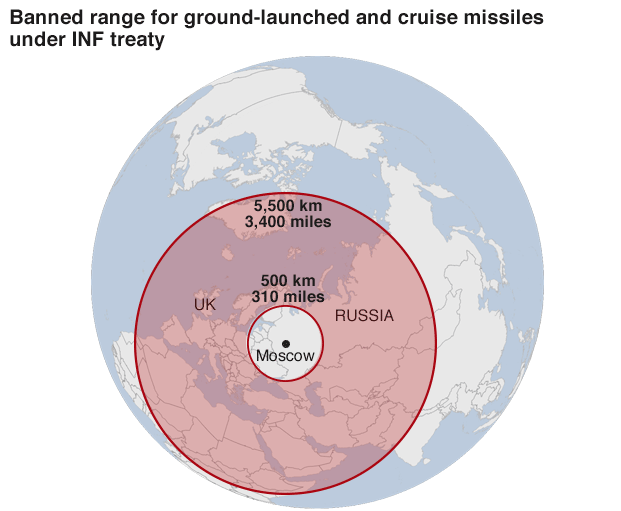Intermediate-Range Nuclear Forces Treaty b/w US and Russia 03/08/2019 – Posted in: Daily News – Tags: New Start treaty, Russian S-400 missile defence system
INTERMEDIATE-RANGE NUCLEAR FORCES TREATY
For: Mains
Topics covered: About Intermediate-range nuclear forces treaty, why the treaty breach, possible threats and associated risks, impacts, Way ahead
News Flash
The US has formally withdrawn from a key nuclear treaty with Russia.
Background
- The Intermediate-Range Nuclear Forces Treaty (INF) was signed by US President Ronald Reagan and Soviet leader Mikhail Gorbachev in 1987.
- It banned missiles with ranges between 500 and 5,500 km (310-3,400 miles).
Allegations
- The US and Nato accused Russia of violating the pact by deploying a new type of cruise missile.
- The US said Russia had deployed a number of 9M729 missiles.
- Russia is solely responsible for the treaty’s demise.
Associated Risks
- Russian missiles were nuclear-capable, mobile, very hard to detect and could reach European cities within minutes.
- Nato does not want a new arms race.
- Nato confirmed there were no plans for the alliance to deploy land-based nuclear missiles of its own in Europe.
- The collapse of the historic agreement could lead to a new arms race between the US, Russia, and China.
- The US said the development of the 9M729 missile system poses significant risks to Euro-Atlantic security.
- The demise of the treaty will likely heighten, not reduce, the threat posed by ballistic missiles.
- Now when the treaty is over, there will be the possibility of development and deployment of new weapons
Intermediate-Range Nuclear Forces (INF) treaty
- The treaty was signed by the US and the USSR in 1987.
- The arms control deal banned all nuclear and non-nuclear missiles with short and medium ranges, except sea-launched weapons.
- US had been concerned by the Soviet deployment of the SS-20 missile system in 1979 and responded by placing Pershing and cruise missiles in Europe – sparking widespread protests
- By 1991, nearly 2,700 missiles had been destroyed
- The two countries were allowed to inspect each other’s installations
Another concern
- The most important agreement of the old Cold War years – the New Start treaty – that limits long-range nuclear weapons is set to expire in February 2021.
- It is more dangerous when new weapons technologies (involving artificial intelligence and high-speed “hypersonic” missiles) are being developed.
Russia’s support to Turkey
- Turkey last month received the first parts of a Russian S-400 missile defence system despite opposition from the US. It also worsening ties between the US and Russia.
- The US has warned that Turkey cannot have both the S-400 anti-aircraft defence system and US F-35 fighter jets.
- Turkey and the US are Nato allies but Turkey has also been establishing closer links with Russia.
Reasons for the breach of treaty
- In 2007, Russian President Vladimir Putin declared the treaty no longer served Russia’s interests.
- That happened after US President George W Bush, in 2002, pulled the US out of the Anti-Ballistic Missile Treaty, which banned weapons designed to counter ballistic nuclear missiles.
- In 2014, then US President Barack Obama accused Russia of breaching the INF Treaty after it allegedly tested a ground-launched cruise missile.
- Last year, Nato supported the US accusations and formally accused Russia of breaking the treaty.
Way ahead
UN Secretary-General, urging all parties to “seek agreement on a new common path for international arms control”.

The banned range for ground-launched and cruise missiles under INF treaty
Source: BBC
Also, read more daily News
- National Commission of Minorities
- RoboBee X-Wing
- Banning of Unregulated Deposit Schemes Bill 2019
- Anti-microbial peptide
You are on the Best Online IAS preparation platform. You are learning under experts.
We are present on Facebook- Diligent IAS, LinkedIn- Diligent IAS, YouTube- Diligent IAS, Instagram- Diligent IAS. Get in touch with us.

